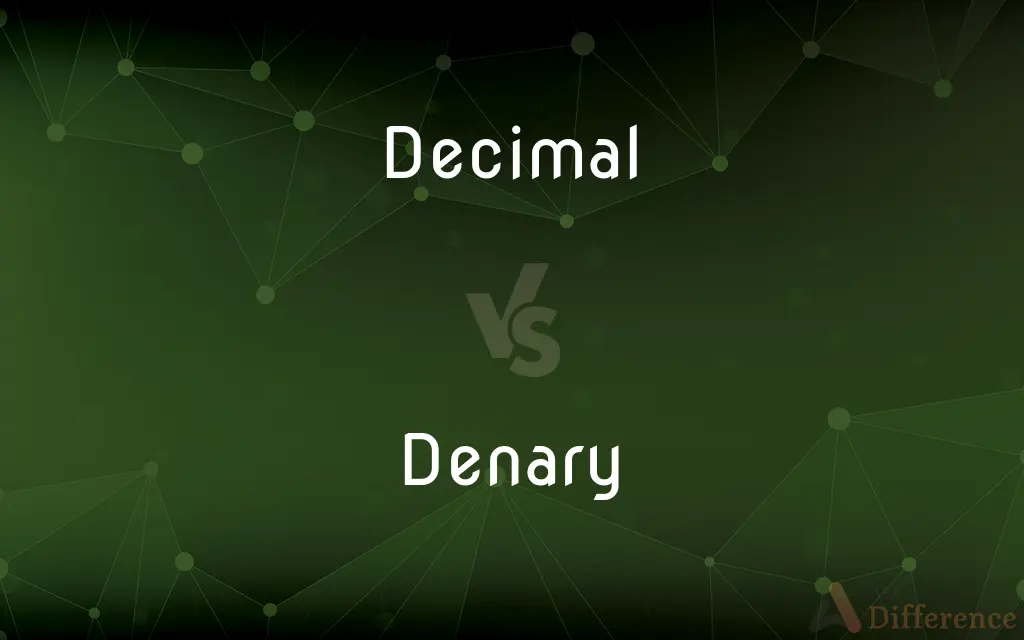Decimal vs. Denary — What's the Difference?
By Tayyaba Rehman & Maham Liaqat — Updated on March 18, 2024
Decimal refers to a base-10 numbering system using digits 0-9, while denary is another term for the decimal system, specifically emphasizing its base-10 nature.

Difference Between Decimal and Denary
Table of Contents
ADVERTISEMENT
Key Differences
Decimal and denary are terms often used interchangeably to describe the base-10 numbering system, which is the standard system for representing numbers in daily life and is characterized by the use of ten digits from 0 to 9. Both terms emphasize the use of ten as a base but may be used in different contexts to highlight specific aspects of the system.
While "decimal" is more commonly used in general mathematics and everyday language, particularly when discussing decimal points and the fractions they represent, "denary" is sometimes preferred in educational contexts or computer science to emphasize the distinction from binary, octal, and hexadecimal systems. This distinction helps clarify that the discussion pertains specifically to the base-10 system, as opposed to systems based on other numbers.
The decimal system's wide adoption is due to its intuitive alignment with human counting habits, which historically have been based on counting fingers — ten in total. On the other hand, denary, derived from the Latin word "denarius," which means "containing ten," explicitly references this base-10 structure, making it especially useful in discussions comparing different base systems.
In practical applications, decimal numbers are used for a vast array of calculations, from financial transactions to measurements in science and engineering. The denary term might be used when teaching the concept of base systems to differentiate between the base-10 system and others like binary (base-2), used in computing, or hexadecimal (base-16), used in programming and digital systems.
Despite the different preferences for usage, the underlying principles of the decimal (denary) system remain the same, including the place value system where the value of a digit depends on its position within a number. This concept is crucial for performing arithmetic operations and for understanding the system’s efficiency in representing large or fractional numbers.
ADVERTISEMENT
Comparison Chart
Definition
A base-10 numbering system using digits 0-9.
Another term for the decimal system, emphasizing its base-10 nature.
Common Usage
General mathematics, everyday counting, and fractions.
Educational and computing contexts to distinguish from other base systems.
Origin
Latin "decimus," meaning "tenth."
Latin "denarius," a Roman coin meaning "containing ten."
Application
Used universally for calculations and measurements.
Used to clarify discussions about numbering systems, especially in comparison to binary or hexadecimal.
Representation
Decimal points to denote fractions.
Focus on the base-10 system without necessarily implying fractions.
Compare with Definitions
Decimal
A fraction whose denominator is a power of ten.
0.75 is a decimal representing three-quarters.
Denary
Pertaining to the number ten.
Ancient Romans used denary as a standard counting method.
Decimal
Relating to or denoting a system of numbers and arithmetic based on the number ten.
Decimal notation is used worldwide for most currency calculations.
Denary
Denoting a system or operations based on the number ten.
Denary addition works just like the addition you learned in school.
Decimal
Pertaining to tenths or to the number system of base ten.
Decimal clocks were once proposed during the French Revolution.
Denary
A term specifically used for the base-10 numbering system.
In denary, the number fifteen is written as 15.
Decimal
Involving numbers expressed in decimal notation.
The decimal version of one-half is 0.5.
Denary
Used to emphasize the contrast with binary or other systems.
Computers operate in binary, not denary.
Decimal
A number system based on ten.
The decimal system simplifies calculations for everyday use.
Denary
Often used in educational contexts to teach about numbering systems.
Students learn about denary before exploring binary and hexadecimal systems.
Decimal
The decimal numeral system (also called the base-ten positional numeral system, and occasionally called denary or decanary) is the standard system for denoting integer and non-integer numbers. It is the extension to non-integer numbers of the Hindu–Arabic numeral system.
Denary
Tenfold.
Decimal
A linear array of digits that contains a single period, called the decimal point, is possibly preceded by a minus sign (-), and represents a real number, with each successive digit to the right of the decimal point indicating a multiple of the next negative power of 10, and each successive digit to the left of the decimal point indicating a multiple of the next non-negative power of ten, beginning with 100 = 1. For example, 245.3 represents the real number (2 × 102) + (4 × 101) + (5 × 100) + (3 × 10-1) = 200 + 40 + 5 + 3/10 , and -1.04 represents the real number (-1 × 100) + (-4 × 10-2). Also called mixed decimal.
Denary
Divided or counted by tens; decimal.
Decimal
Such an array of digits in which there are no nonzero digits to the left of the decimal point, representing a real number between -1 and 1. Also called decimal fraction.
Denary
An ancient coin, the denarius.
Decimal
A number written using the base 10.
Denary
Containing ten parts.
Decimal
Expressed or expressible as a decimal.
Denary
Based on the number ten.
Decimal
Based on 10.
Denary
Containing ten; tenfold; proceeding by tens; as, the denary, or decimal, scale.
Decimal
Numbered or ordered by groups of 10.
Denary
The number ten; a division into ten.
Decimal
(countable) A number expressed in the base-ten system, (particularly) a fractional numeral written in this system.
Denary
A coin; the Anglicized form of denarius.
Decimal
The decimal system itself.
Denary
Containing ten or ten parts
Decimal
(informal) A decimal place.
Pi has a value of 3.142, to three decimals.
Denary
Numbered or proceeding by tens; based on ten;
The decimal system
Decimal
(informal) A decimal point.
Decimal
Concerning numbers expressed in decimal or mathematical calculations performed using decimal.
Decimal
To represent with numbers after a decimal point.
Decimal
Of or pertaining to decimals; numbered or proceeding by tens; having a tenfold increase or decrease, each unit being ten times the unit next smaller; as, decimal notation; a decimal coinage.
Decimal
A number expressed in the scale of tens; specifically, and almost exclusively, used as synonymous with a decimal fraction.
Decimal
A proper fraction whose denominator is a power of 10
Decimal
A number in the decimal system
Decimal
Numbered or proceeding by tens; based on ten;
The decimal system
Decimal
Divided by tens or hundreds;
A decimal fraction
Decimal coinage
Common Curiosities
Why use the term denary instead of decimal?
"Denary" is often used in educational or technical contexts to distinguish the base-10 system from other numbering systems like binary or hexadecimal.
What is the significance of the decimal point?
The decimal point separates the whole number part from the fractional part in a decimal number, allowing for precise representation of values.
Is the decimal system used worldwide?
Yes, the decimal system is the standard numbering system used worldwide for most calculations, measurements, and financial transactions.
Are decimal and denary the same?
Yes, both terms refer to the base-10 numbering system, though "denary" is specifically used to emphasize the base-10 aspect.
Can decimals represent fractions?
Yes, decimals can represent fractions, with the decimal point separating the whole number part from the fractional part.
Why is the decimal system so common?
Its intuitiveness and the simplicity of having a base related to the number of human fingers likely contributed to its widespread adoption.
How does the decimal system work?
The decimal system is based on ten digits (0-9), with each digit's value depending on its position and a base of ten.
How are decimal and denary used in computing?
While computing primarily uses binary, understanding decimal and denary is crucial for programmers and engineers when interfacing with human users and interpreting binary data.
What role does the decimal system play in education?
It is fundamental to mathematics education, serving as the basis for teaching arithmetic operations, fractions, and place value.
What future developments might impact the decimal system?
Technological advancements may lead to wider public understanding of alternative number systems (like binary for digital devices), but the decimal system's fundamental role in daily life and education is likely to remain unchanged.
Are there any alternatives to the decimal system?
Yes, there are alternatives like the binary system (base-2), used in computing, and the hexadecimal system (base-16), used in digital systems.
How did the decimal system originate?
The decimal system's origins can be traced back to ancient civilizations, with its development influenced by the natural human tendency to count using fingers.
Can the decimal system represent all types of numbers?
Yes, it can represent whole numbers, fractions, and irrational numbers through decimal expansion.
How do different cultures view the decimal system?
While the decimal system is universally adopted, some cultures have historical numbering systems with different bases, though these are generally not used in official contexts.
What are the advantages of the decimal system?
Its base-10 structure aligns with human counting habits, making it intuitive and easy to use for a wide range of calculations and measurements.
Share Your Discovery

Previous Comparison
Multitude vs. Multitudinous
Next Comparison
Exchange vs. ReplaceAuthor Spotlight
Written by
Tayyaba RehmanTayyaba Rehman is a distinguished writer, currently serving as a primary contributor to askdifference.com. As a researcher in semantics and etymology, Tayyaba's passion for the complexity of languages and their distinctions has found a perfect home on the platform. Tayyaba delves into the intricacies of language, distinguishing between commonly confused words and phrases, thereby providing clarity for readers worldwide.
Co-written by
Maham Liaqat













































